Devolopment of new meanings
Devolopment of new meanings
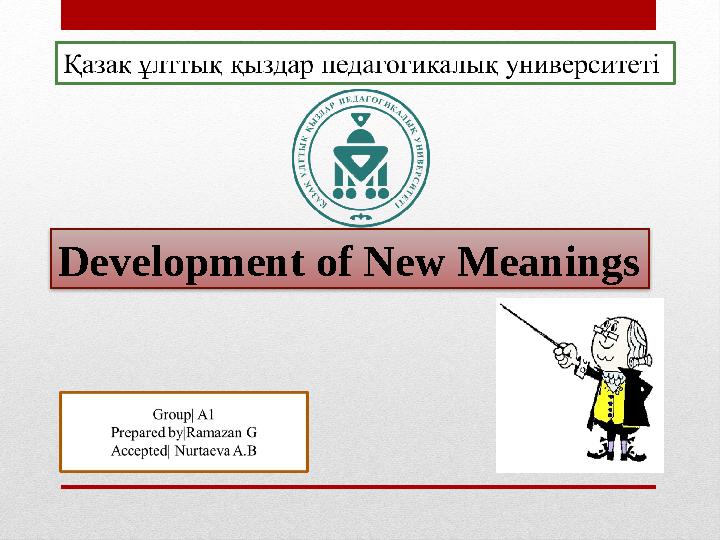

#1 слайд
Development of New Meanings
1 слайд
Development of New Meanings
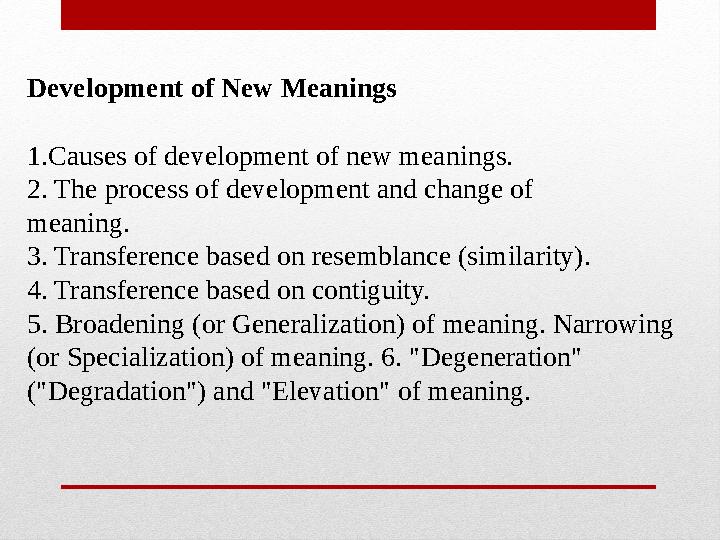
#2 слайд
Development of New Meanings
1. Causes of development of new meanings.
2. The process of development and change of
meaning.
3. Transference based on resemblance (similarity).
4. Transference based on contiguity.
5. Broadening (or Generalization) of meaning. Narrowing
(or Specialization) of meaning. 6. "Degeneration"
("Degradation") and "Elevation" of meaning.
2 слайд
Development of New Meanings 1. Causes of development of new meanings. 2. The process of development and change of meaning. 3. Transference based on resemblance (similarity). 4. Transference based on contiguity. 5. Broadening (or Generalization) of meaning. Narrowing (or Specialization) of meaning. 6. "Degeneration" ("Degradation") and "Elevation" of meaning.
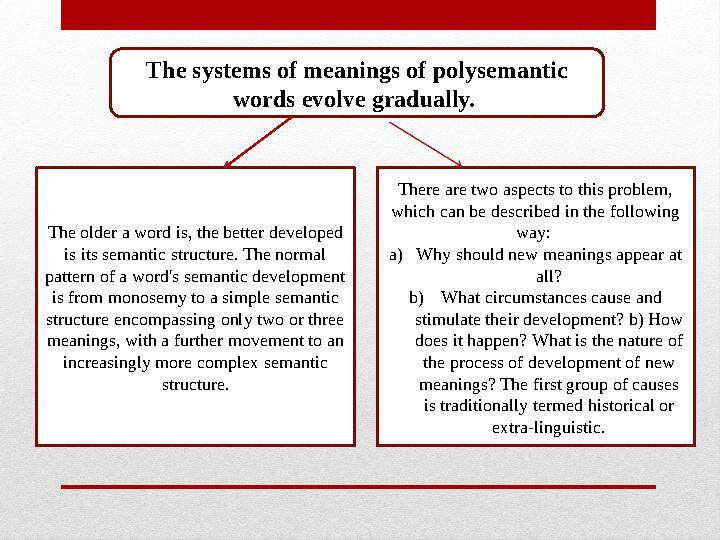
#3 слайд
The older a word is, the better developed
is its semantic structure. The normal
pattern of a word's semantic development
is from monosemy to a simple semantic
structure encompassing only two or three
meanings, with a further movement to an
increasingly more complex semantic
structure. There are two aspects to this problem,
which can be described in the following
way:
a) Why should new meanings appear at
all?
b) What circumstances cause and
stimulate their development? b) How
does it happen? What is the nature of
the process of development of new
meanings? The first group of causes
is traditionally termed historical or
extra-linguistic.The systems of meanings of polysemantic
words evolve gradually.
3 слайд
The older a word is, the better developed is its semantic structure. The normal pattern of a word's semantic development is from monosemy to a simple semantic structure encompassing only two or three meanings, with a further movement to an increasingly more complex semantic structure. There are two aspects to this problem, which can be described in the following way: a) Why should new meanings appear at all? b) What circumstances cause and stimulate their development? b) How does it happen? What is the nature of the process of development of new meanings? The first group of causes is traditionally termed historical or extra-linguistic.The systems of meanings of polysemantic words evolve gradually.
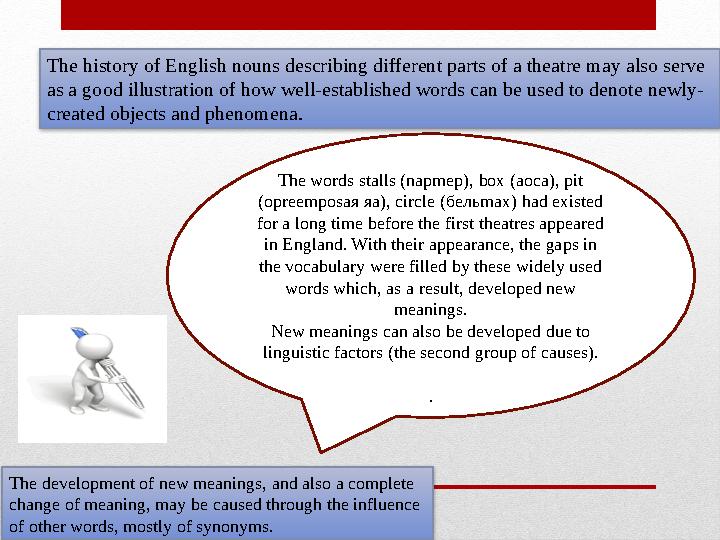
#4 слайд
The words stalls (napmep), box (aoca), pit
(opreempоsая яa), circle (бeльmax) had existed
for a long time before the first theatres appeared
in England. With their appearance, the gaps in
the vocabulary were filled by these widely used
words which, as a result, developed new
meanings.
New meanings can also be developed due to
linguistic factors (the second group of causes).
.The history of English nouns describing different parts of a theatre may also serve
as a good illustration of how well-established words can be used to denote newly-
created objects and phenomena.
The development of new meanings, and also a complete
change of meaning, may be caused through the influence
of other words, mostly of synonyms.
4 слайд
The words stalls (napmep), box (aoca), pit (opreempоsая яa), circle (бeльmax) had existed for a long time before the first theatres appeared in England. With their appearance, the gaps in the vocabulary were filled by these widely used words which, as a result, developed new meanings. New meanings can also be developed due to linguistic factors (the second group of causes). .The history of English nouns describing different parts of a theatre may also serve as a good illustration of how well-established words can be used to denote newly- created objects and phenomena. The development of new meanings, and also a complete change of meaning, may be caused through the influence of other words, mostly of synonyms.
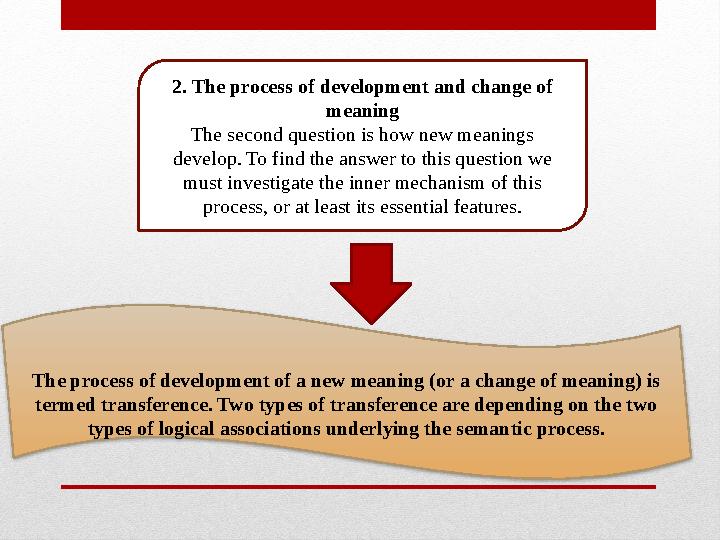
#5 слайд
2. The process of development and change of
meaning
The second question is how new meanings
develop. To find the answer to this question we
must investigate the inner mechanism of this
process, or at least its essential features.
The process of development of a new meaning (or a change of meaning) is
termed transference. Two types of transference are depending on the two
types of logical associations underlying the semantic process.
5 слайд
2. The process of development and change of meaning The second question is how new meanings develop. To find the answer to this question we must investigate the inner mechanism of this process, or at least its essential features. The process of development of a new meaning (or a change of meaning) is termed transference. Two types of transference are depending on the two types of logical associations underlying the semantic process.
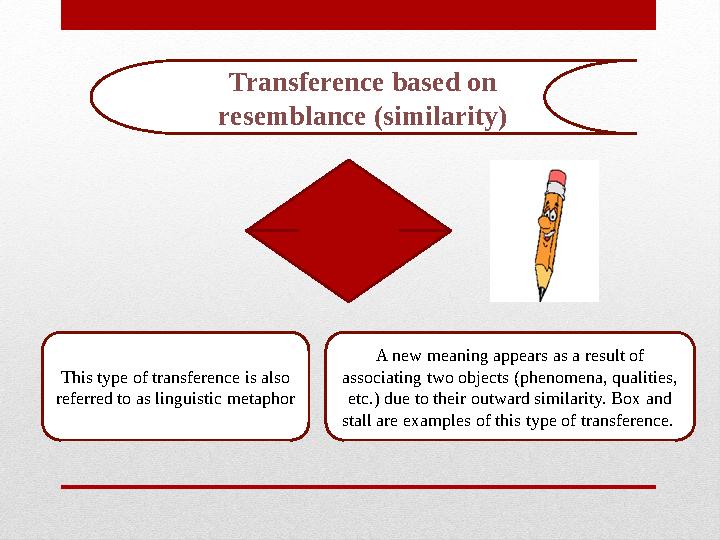
#6 слайд
Transference based on
resemblance (similarity)
This type of transference is also
referred to as linguistic metaphor A new meaning appears as a result of
associating two objects (phenomena, qualities,
etc.) due to their outward similarity. Box and
stall are examples of this type of transference.
6 слайд
Transference based on resemblance (similarity) This type of transference is also referred to as linguistic metaphor A new meaning appears as a result of associating two objects (phenomena, qualities, etc.) due to their outward similarity. Box and stall are examples of this type of transference.
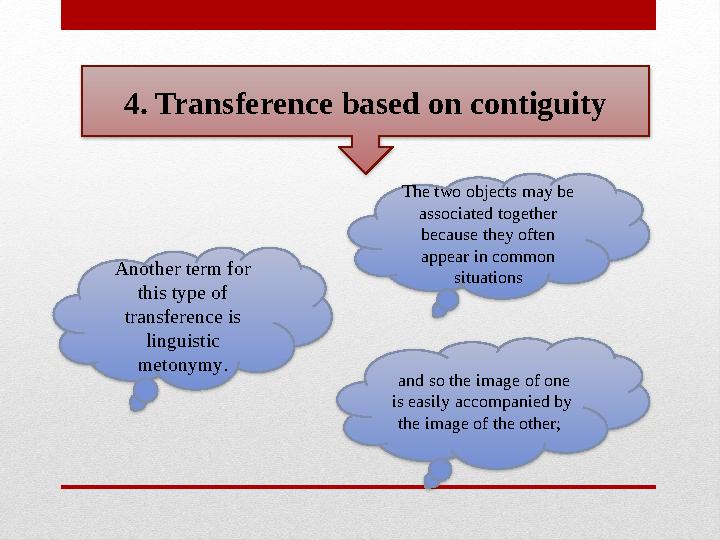
#7 слайд
4. Transference based on contiguity
Another term for
this type of
transference is
linguistic
metonymy . The two objects may be
associated together
because they often
appear in common
situations
and so the image of one
is easily accompanied by
the image of the other;
7 слайд
4. Transference based on contiguity Another term for this type of transference is linguistic metonymy . The two objects may be associated together because they often appear in common situations and so the image of one is easily accompanied by the image of the other;
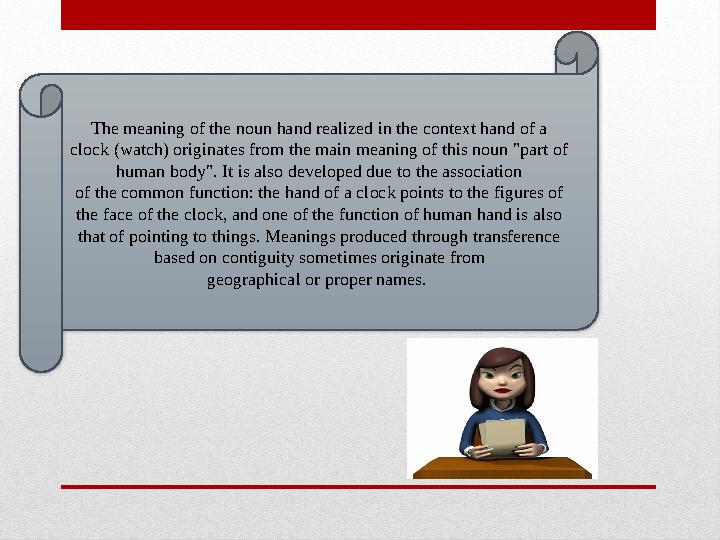
#8 слайд
The meaning of the noun hand realized in the context hand of a
clock (watch) originates from the main meaning of this noun "part of
human body". It is also developed due to the association
of the common function: the hand of a clock points to the figures of
the face of the clock, and one of the function of human hand is also
that of pointing to things. Meanings produced through transference
based on contiguity sometimes originate from
geographical or proper names.
8 слайд
The meaning of the noun hand realized in the context hand of a clock (watch) originates from the main meaning of this noun "part of human body". It is also developed due to the association of the common function: the hand of a clock points to the figures of the face of the clock, and one of the function of human hand is also that of pointing to things. Meanings produced through transference based on contiguity sometimes originate from geographical or proper names.
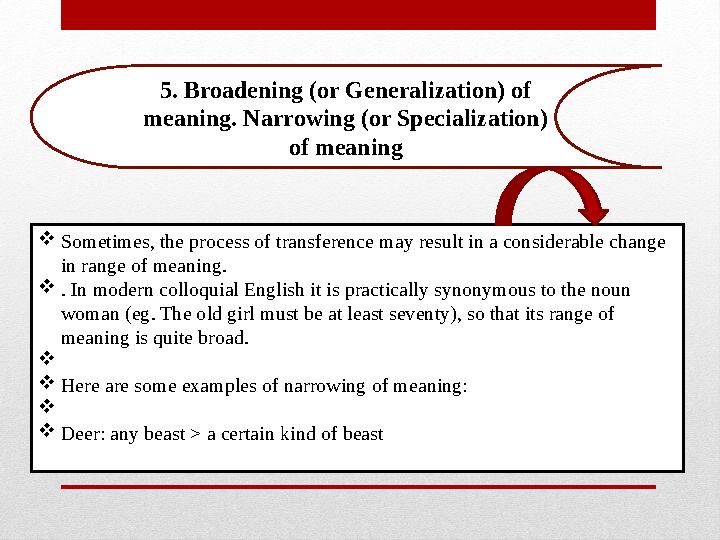
#9 слайд
5. Broadening (or Generalization) of
meaning. Narrowing (or Specialization)
of meaning
Sometimes, the process of transference may result in a considerable change
in range of meaning.
. In modern colloquial English it is practically synonymous to the noun
woman (eg. The old girl must be at least seventy), so that its range of
meaning is quite broad.
Here are some examples of narrowing of meaning:
Deer: any beast > a certain kind of beast
9 слайд
5. Broadening (or Generalization) of meaning. Narrowing (or Specialization) of meaning Sometimes, the process of transference may result in a considerable change in range of meaning. . In modern colloquial English it is practically synonymous to the noun woman (eg. The old girl must be at least seventy), so that its range of meaning is quite broad. Here are some examples of narrowing of meaning: Deer: any beast > a certain kind of beast

#10 слайд
6. "Degeneration" ("Degradation") and
"Elevation" of meaning
Let us see what stands
behind the examples of
change of meaning
which illustrate
degeneration and
elevation of meaning. "Degeneration" of meaning.
Knave: boy >swindler,
scoundrel
Gossip god parent> the one
who tells slanderous stories
about other people
10 слайд
6. "Degeneration" ("Degradation") and "Elevation" of meaning Let us see what stands behind the examples of change of meaning which illustrate degeneration and elevation of meaning. "Degeneration" of meaning. Knave: boy >swindler, scoundrel Gossip god parent> the one who tells slanderous stories about other people
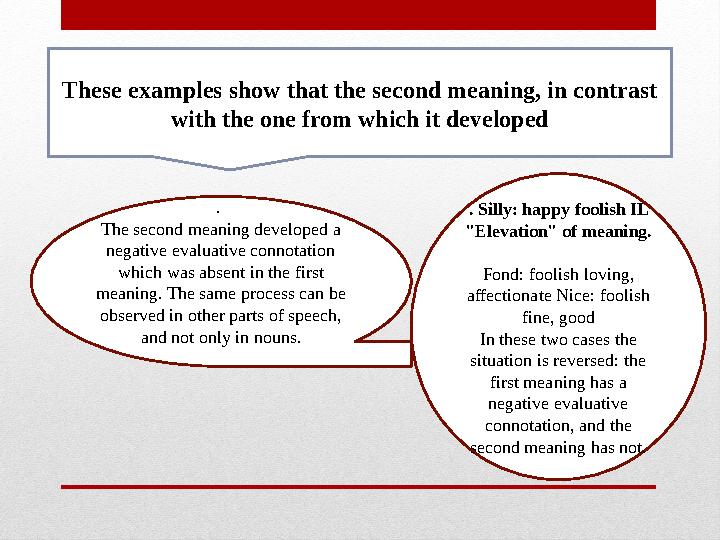
#11 слайд
These examples show that the second meaning, in contrast
with the one from which it developed
.
The second meaning developed a
negative evaluative connotation
which was absent in the first
meaning. The same process can be
observed in other parts of speech,
and not only in nouns. . Silly: happy foolish IL
"Elevation" of meaning.
Fond: foolish loving,
affectionate Nice: foolish
fine, good
In these two cases the
situation is reversed: the
first meaning has a
negative evaluative
connotation, and the
second meaning has not.
11 слайд
These examples show that the second meaning, in contrast with the one from which it developed . The second meaning developed a negative evaluative connotation which was absent in the first meaning. The same process can be observed in other parts of speech, and not only in nouns. . Silly: happy foolish IL "Elevation" of meaning. Fond: foolish loving, affectionate Nice: foolish fine, good In these two cases the situation is reversed: the first meaning has a negative evaluative connotation, and the second meaning has not.

#12 слайд
Thank you for attention
12 слайд
Thank you for attention

шағым қалдыра аласыз
















